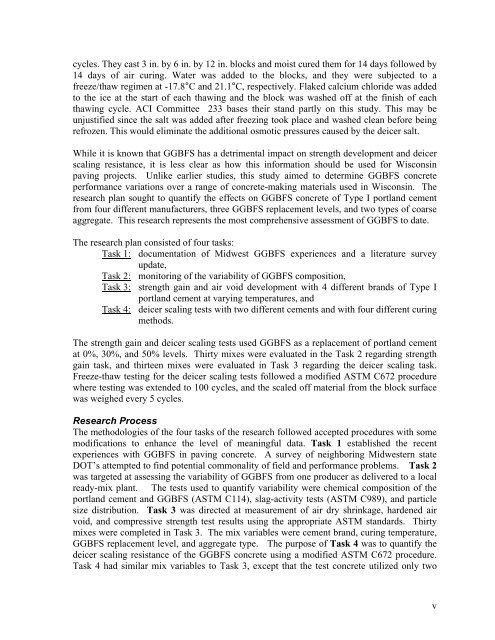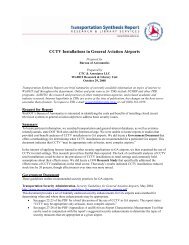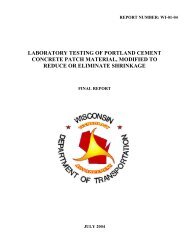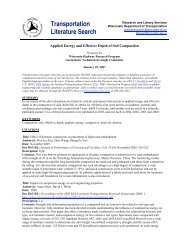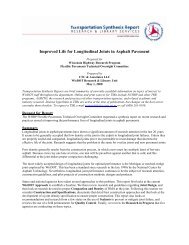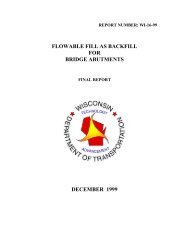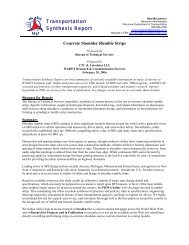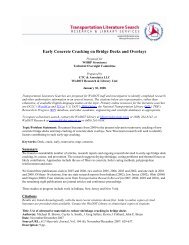Effects of Ground Granulated Blast Furnace Slag in Portland Cement ...
Effects of Ground Granulated Blast Furnace Slag in Portland Cement ...
Effects of Ground Granulated Blast Furnace Slag in Portland Cement ...
You also want an ePaper? Increase the reach of your titles
YUMPU automatically turns print PDFs into web optimized ePapers that Google loves.
cycles. They cast 3 <strong>in</strong>. by 6 <strong>in</strong>. by 12 <strong>in</strong>. blocks and moist cured them for 14 days followed by<br />
14 days <strong>of</strong> air cur<strong>in</strong>g. Water was added to the blocks, and they were subjected to a<br />
freeze/thaw regimen at -17.8°C and 21.1°C, respectively. Flaked calcium chloride was added<br />
to the ice at the start <strong>of</strong> each thaw<strong>in</strong>g and the block was washed <strong>of</strong>f at the f<strong>in</strong>ish <strong>of</strong> each<br />
thaw<strong>in</strong>g cycle. ACI Committee 233 bases their stand partly on this study. This may be<br />
unjustified s<strong>in</strong>ce the salt was added after freez<strong>in</strong>g took place and washed clean before be<strong>in</strong>g<br />
refrozen. This would elim<strong>in</strong>ate the additional osmotic pressures caused by the deicer salt.<br />
While it is known that GGBFS has a detrimental impact on strength development and deicer<br />
scal<strong>in</strong>g resistance, it is less clear as how this <strong>in</strong>formation should be used for Wiscons<strong>in</strong><br />
pav<strong>in</strong>g projects. Unlike earlier studies, this study aimed to determ<strong>in</strong>e GGBFS concrete<br />
performance variations over a range <strong>of</strong> concrete-mak<strong>in</strong>g materials used <strong>in</strong> Wiscons<strong>in</strong>. The<br />
research plan sought to quantify the effects on GGBFS concrete <strong>of</strong> Type I portland cement<br />
from four different manufacturers, three GGBFS replacement levels, and two types <strong>of</strong> coarse<br />
aggregate. This research represents the most comprehensive assessment <strong>of</strong> GGBFS to date.<br />
The research plan consisted <strong>of</strong> four tasks:<br />
Task 1: documentation <strong>of</strong> Midwest GGBFS experiences and a literature survey<br />
update,<br />
Task 2: monitor<strong>in</strong>g <strong>of</strong> the variability <strong>of</strong> GGBFS composition,<br />
Task 3: strength ga<strong>in</strong> and air void development with 4 different brands <strong>of</strong> Type I<br />
portland cement at vary<strong>in</strong>g temperatures, and<br />
Task 4: deicer scal<strong>in</strong>g tests with two different cements and with four different cur<strong>in</strong>g<br />
methods.<br />
The strength ga<strong>in</strong> and deicer scal<strong>in</strong>g tests used GGBFS as a replacement <strong>of</strong> portland cement<br />
at 0%, 30%, and 50% levels. Thirty mixes were evaluated <strong>in</strong> the Task 2 regard<strong>in</strong>g strength<br />
ga<strong>in</strong> task, and thirteen mixes were evaluated <strong>in</strong> Task 3 regard<strong>in</strong>g the deicer scal<strong>in</strong>g task.<br />
Freeze-thaw test<strong>in</strong>g for the deicer scal<strong>in</strong>g tests followed a modified ASTM C672 procedure<br />
where test<strong>in</strong>g was extended to 100 cycles, and the scaled <strong>of</strong>f material from the block surface<br />
was weighed every 5 cycles.<br />
Research Process<br />
The methodologies <strong>of</strong> the four tasks <strong>of</strong> the research followed accepted procedures with some<br />
modifications to enhance the level <strong>of</strong> mean<strong>in</strong>gful data. Task 1 established the recent<br />
experiences with GGBFS <strong>in</strong> pav<strong>in</strong>g concrete. A survey <strong>of</strong> neighbor<strong>in</strong>g Midwestern state<br />
DOT’s attempted to f<strong>in</strong>d potential commonality <strong>of</strong> field and performance problems. Task 2<br />
was targeted at assess<strong>in</strong>g the variability <strong>of</strong> GGBFS from one producer as delivered to a local<br />
ready-mix plant. The tests used to quantify variability were chemical composition <strong>of</strong> the<br />
portland cement and GGBFS (ASTM C114), slag-activity tests (ASTM C989), and particle<br />
size distribution. Task 3 was directed at measurement <strong>of</strong> air dry shr<strong>in</strong>kage, hardened air<br />
void, and compressive strength test results us<strong>in</strong>g the appropriate ASTM standards. Thirty<br />
mixes were completed <strong>in</strong> Task 3. The mix variables were cement brand, cur<strong>in</strong>g temperature,<br />
GGBFS replacement level, and aggregate type. The purpose <strong>of</strong> Task 4 was to quantify the<br />
deicer scal<strong>in</strong>g resistance <strong>of</strong> the GGBFS concrete us<strong>in</strong>g a modified ASTM C672 procedure.<br />
Task 4 had similar mix variables to Task 3, except that the test concrete utilized only two<br />
v


